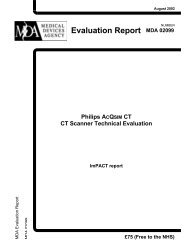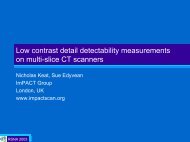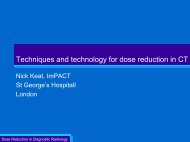Purchasing a cardiac CT scanner: What the radiologist needs to know
Purchasing a cardiac CT scanner: What the radiologist needs to know
Purchasing a cardiac CT scanner: What the radiologist needs to know
You also want an ePaper? Increase the reach of your titles
YUMPU automatically turns print PDFs into web optimized ePapers that Google loves.
<strong>Purchasing</strong> a <strong>cardiac</strong> <strong>CT</strong> <strong>scanner</strong>:<strong>What</strong> <strong>the</strong> <strong>radiologist</strong> <strong>needs</strong> <strong>to</strong> <strong>know</strong>Maria LewisImPA<strong>CT</strong>St George’s Hospital, Londonmaria.lewis@stgeorges.nhs.ukUKRC 2010
Conventional C<strong>CT</strong>A scan modes• Helical• Axial (Step and Shoot)– constant mA– with ‘padding’Max– mA modulated– single phaseMinUKRC 2010IrradiationReconstruction
Cardiac <strong>CT</strong>: technical requirements (C<strong>CT</strong>A)• Temporal resolution• Spatial resolution• Volume coverage• Dose• O<strong>the</strong>r considerationsUKRC 2010
Cardiac <strong>CT</strong>: technical requirements (C<strong>CT</strong>A)• Temporal resolution• Spatial resolution• Volume coverage• Dose• O<strong>the</strong>r considerationsUKRC 2010
Temporal resolution• Reconstruct images in most stationary phase of <strong>cardiac</strong>cycle– best phase dependant on heart ratephaseCardiacmotiontUKRC 2010Optimal reconphase
How <strong>to</strong> improve temporal resolution• Fast rotation times– currently 270 – 350 ms– 360° reconstruction not suitable• Half-scan reconstruction method– temporal resolution (TR) ≅ ½ rotation time60 bpmR – R~ 1000 ms~ 150 ms300 ms rotation150 msUKRC 2010
How <strong>to</strong> improve temporal resolution• Multi-segment reconstruction– uses multiple heart beats for image reconstruction– 2 segments: max TR ~ 1 /4 rotation time– 3 segments: max TR ~ 1 /6 rotation time ….etc• Temporal resolution achieved dependent on heart rate– can be optimised by adjusting rotation time300 ms rotation1st 90°data2nd 90°data1 st heartbeatUKRC 2010temporalresolution75 ms2 nd heartbeat
Temporal resolutionScanner modelTubes(#)Rotation(ms)Temporal resolution(ms)AxialHelicalGE Discovery <strong>CT</strong>750 HD135017544 - 175Philips Brilliance i<strong>CT</strong>127013534 - 135Siemens Definition Flash22857538 - 75Toshiba Aquilion ONE135035 - 17535 - 175UKRC 2010
Cardiac <strong>CT</strong>: technical requirements• Temporal resolution• Spatial resolution• Volume coverage• Dose• O<strong>the</strong>r considerationsUKRC 2010
Spatial resolution• Ability <strong>to</strong> discern small, high contraststructures10 line pairs/cm≡ 0.5 mm• Isotropic spatial resolution required– equal resolution in all planesUKRC 2010Voxel size: x=y=z
Spatial resolution• Spatial resolution dependent on– focal spot and detec<strong>to</strong>r size– sampling density• Also dependent on– reconstruction parameters e.g. reconstruction filter– temporal resolutionScan axis(z)Scan plane(x-y)UKRC 201040 mm (64 x 0.625 mm)
How <strong>to</strong> improve spatial resolution• Flying (dynamic) focal spot (FFS)– improves sampling density– reduces artefactsx-y planeFFS availabilityManufacturer*x-y planez-axisGEPhilipsYesYesNoYesz-axis(helical)0,6 mmSiemensYesYes0,6 mmToshibaNoNo* Not available on all <strong>scanner</strong> modelsUKRC 2010
Spatial resolution• Limiting spatial resolution:– up <strong>to</strong> 15 - 25 lp/cm (0.3 - 0.2 mm) in scan plane– up <strong>to</strong> ~13 lp/cm (0.4 mm) in z-axisCourtesy Siemens• Sharpest reconstruction filters result in high noise• Generally for standard <strong>cardiac</strong> scans– x-y plane resolution ~ 8 lp/cm (0.6 mm)– z-axis resolution ~ 13 lp/cm (0.4 mm)• For reduced ‘blooming’ e.g. stents, calcium– sharper filters may be used ~ 10 lp/cm (0.5 mm)UKRC 2010Images from Lin, EC et al; http://emedicine.medscape.com/article/1603072-overview
Cardiac <strong>CT</strong>: technical requirements• Temporal resolution• Spatial resolution• Volume coverage• Dose• O<strong>the</strong>r considerationsUKRC 2010
Volume coverage• z-axis detec<strong>to</strong>r configuration of <strong>to</strong>p-of-<strong>the</strong>-range <strong>CT</strong> <strong>scanner</strong>sSiemens Soma<strong>to</strong>m Definition Flash – ‘128 slice <strong>scanner</strong>’64 x 0.6 mmGE Discovery <strong>CT</strong>750 HD – ‘64 slice <strong>scanner</strong>’64 x 0.625 mmPhilips Brilliance i<strong>CT</strong> – ‘256 slice <strong>scanner</strong>’128 x 0.625 mm128 data channels*38.4 mm coverage64 data channels40 mm coverage256 data channels**80 mm coverageToshiba Aquilion ONE – ‘640 slice <strong>scanner</strong>’320 x 0.5 mm320 data channels***160 mm coveragez-axis* 64 detec<strong>to</strong>r banks double-sampled** 128 detec<strong>to</strong>r banks double-sampled*** 640 slices from one axial acquisitionUKRC 2010
Volume coverage• Consider detec<strong>to</strong>r length NOT ‘no. of slices’• Number of heart beats required <strong>to</strong> cover volume depends on– detec<strong>to</strong>r length– scan modeNo. of heart beats required: 140 mm length, single segmentDetec<strong>to</strong>r length (mm)Scan mode4080160Axial (step and shoot)731Helical – low pitch42-Helical – high pitch1--UKRC 2010
Volume coverage – ‘single beat’• Full organ coverage– <strong>cardiac</strong> scanning: triggered axial mode, no table movement• Single beat, single rotation– standard C<strong>CT</strong>A• Single beat, multiple rotations– increased flexibility• Single beat, modulated– C<strong>CT</strong>A + functional• Multi-beat, pulsed– C<strong>CT</strong>A, multi-segment• Multi-beat, continuous– perfusionUKRC 2010Irradiation
Volume coverage• Wide detec<strong>to</strong>r coverage– cone beam artefact: 3D reconstruction method– scatter: software corrections– roof-<strong>to</strong>p effect: software corrections available on some systemsImagedvolumeUKRC 2010Nominal detec<strong>to</strong>rarray width defined atiso-centre
Volume coverage• Reduced roof-<strong>to</strong>p effect – Toshiba Aquilion ONEVersion 4.51 Version 4.61160 mm125 mmUKRC 2010
Volume coverage – ‘single beat’• High pitch helical (Siemens ‘Flash’ mode)– prospectively triggered helical mode– couch speed ~ 135 mm per rotation– <strong>cardiac</strong> volume acquired within single heartbeatFlash mode < 1 sec (Pitch 3.4)Tube 1Tube 2RRUKRC 2010
Volume coverage• High pitch helical– limited <strong>to</strong> lower heart rates (
Cardiac <strong>CT</strong>: technical requirements• Temporal resolution• Spatial resolution• Volume coverage• Image noise• Dose• O<strong>the</strong>r considerationsUKRC 2010
Dose in <strong>cardiac</strong> <strong>CT</strong>• Dose primarily dependent on:– scan mode– scan pro<strong>to</strong>col– dose reduction features• Choice of scan mode and pro<strong>to</strong>col dependent on patient– heart rate– heart rate variability– patient sizeUKRC 2010
Dose in <strong>cardiac</strong> <strong>CT</strong>• Scan modeHelicalconstant mAmodulated mAAxialfull cyclenarrow windowUKRC 2010
Dose in Cardiac <strong>CT</strong>Variation of dose with scan mode: Siemens Definition Flash**Helical – low pitch scan – no ECG modulation : 10 mSvScan modeMaximum mA windowDose outside max mA windowAxial (step and shoot)01.2Narrow(Single phase)4%*Effective dose (mSv)25%04.8Wide(40% phase range)4%*25%Helical – low pitch1.73.45.66.4Helical – high pitch (Flash mode)0.8* Siemens MinDose**Doses obtained using Siemens’ Cardiac Dose Calcula<strong>to</strong>r (Accuracy ±10%)Assuming: 60 bpm, BMI 25; 0.014 mSv/DLPScan parameters: 100 kV, 160 mAs/rot/tube, 140 mm scan lengthScanner software version VA 34UKRC 2010
Dose in <strong>cardiac</strong> <strong>CT</strong>• Selection of appropriate mA and kV– au<strong>to</strong>matic selection of mA may beavailable• Use of small FOV bow-tie filter– reduces peripheral dose• Use of iterative reconstruction– less noise at same dose– ~ 50% dose reduction for sameimage quality claimedFBPASIRUKRC 2010From Silva et al AJR Jan 2010
Dose in <strong>cardiac</strong> <strong>CT</strong>• All manufacturers offer iterative reconstructionManufacturerGEPhilipsSiemensToshibaIterative reconstructionAdaptive Statistical Image Reconstruction (ASIR)iDOSEIterative Reconstruction in Image Space (IRIS)Adaptive Iterative Dose Reduction (AIDR)• Second generation iterative reconstruction methodscurrently in developmente.g. GE: Model-based Iterative Reconstruction (Veo)Siemens: Sinogram Affirmative Iterative Reconstruction (SAFIRE)UKRC 2010
Dose in <strong>cardiac</strong> <strong>CT</strong>• Optimisation of scan length:Dose increase ~10% per cm 1– ‘adaptive collimation’ for wide beamaxial scans– ‘dynamic collimation’ <strong>to</strong> reduce overrangingin helical scansIrradiatedrange• Partial irradiation <strong>to</strong> reduce surfaceorgan doseLow dose– breast dose reduction up <strong>to</strong> 40% 2Imaged rangeSiemens X-CAREX-rays OFF1With a base scan length of 10 cm2Kalender W. et al. Reduction of dose <strong>to</strong> <strong>the</strong> female breast inthoracic <strong>CT</strong>; European Society of Radiology 2008; 18: 1674-1682UKRC 2010High doseCourtesy Siemens Medical Systems
Cardiac <strong>CT</strong>: technical requirements• Temporal resolution• Spatial resolution• Volume coverage• Image noise• Dose• O<strong>the</strong>r considerationsUKRC 2010
O<strong>the</strong>r considerations• User-friendliness– au<strong>to</strong>mated scan parameter optimisation– applications software / post-processing• Additional features– dual energy for e.g. myocardial perfusion, direct boneremoval, virtual non-contrast, plaque differentiation….UKRC 2010
O<strong>the</strong>r considerations• Dual energy approachesManufacturerSiemensGEPhilipsDual energy methodDual source technologyRapid kV switching with ‘flying-focal spot’Dual-layer detec<strong>to</strong>rPhilips dual-layer detec<strong>to</strong>rLow energyx-raysUKRC 2010High energy x-rays
Conclusions• Cardiac <strong>CT</strong> scans benefit particularly from a high temporaland spatial resolution as well as fast volume coverage• Cardiac doses depend largely on scan mode – choice ofmode is mainly patient determined• Optimal parameters and dose saving features should be used• Manufacturers have moved in different directions in <strong>scanner</strong>development• The ‘best’ <strong>scanner</strong> is dependent on local <strong>needs</strong>– dedicated <strong>cardiac</strong>, dedicated A&E, general purpose <strong>scanner</strong>…• …and also £££££UKRC 2010
Market reviewMarket review: Advanced <strong>CT</strong> <strong>scanner</strong>s for coronary angiographyCEP10043, March 2010www.dh.gov.uk/cepwww.impactscan.orgUKRC 2010














